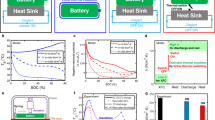Abstract
Energy storage technology is considered as a critical component of the current energy supply chain. The efficiency and dispatchability of power generation from renewable energy sources can be increased using thermal energy storage (TES). Moreover, high-temperature latent heat storage (depicted as thermal battery) can provide cost-competitive solution to obtain significant energy storage density and small charging duration. This study illustrates the methodology to compare the performance of thermal batteries with existing Li-ion batteries. The charging duration of the designed thermal battery is found to be 23 min smaller than Li-ion cell with the smallest heat flux (625 W/m2). Moreover, the gravimetric and volumetric energy density of the thermal battery is observed to be nearly four times higher than the selected Li-ion cell. This present study establishes the high-temperature latent storage-based thermal battery as a potential alternative to storage technology.
Access this chapter
Tax calculation will be finalised at checkout
Purchases are for personal use only
Similar content being viewed by others
Abbreviations
- LHS:
-
Latent heat storage
- Li-ion:
-
Lithium ion
- PCM:
-
Phase change medium
- SHS:
-
Sensible heat storage
- TCHS:
-
Thermochemical heat storage
- TES:
-
Thermal energy storage
- Tref, ρref:
-
Reference temperature and density
- \(\delta\) :
-
Melting fraction
- \(\gamma\) :
-
Mushy zone constant
- \(\beta\) :
-
Coefficient of thermal expansion
- μ:
-
Dynamic viscosity
References
Perera F (2018) Pollution from fossil-fuel combustion is the leading environmental threat to global pediatric health and equity: Solutions exist. Int J Environ Res Public Health 15(1). https://doi.org/10.3390/IJERPH15010016
Zablocki A (2019) Energy storage: Fact sheet (2019). Eesi, 2040:1–8 [Online]. Available: https://www.eesi.org/papers/view/energy-storage-2019
Aneke M, Wang M (2016) Energy storage technologies and real life applications—A state of the art review. Appl Energy 179:350–377. https://doi.org/10.1016/j.apenergy.2016.06.097
Ray AK, Rakshit D, Ravikumar K (2021) High-temperature latent thermal storage system for solar power: Materials, concepts, and challenges. Clean. Eng. Technol. 4:100155. https://doi.org/10.1016/j.clet.2021.100155
Chen T, ** Y, Lv H, Yang A, Liu M, Chen B, **e Y, Chen Q (2020) Applications of lithium-ion batteries in grid-scale energy storage systems. Trans Tian** Univ 26(3):208–217. https://doi.org/10.1007/S12209-020-00236-W
Tetteh S, Yazdani MR, Santasalo-Aarnio A (2021) Cost-effective electro-thermal energy storage to balance small scale renewable energy systems. J Energy Storage 41:102829. https://doi.org/10.1016/J.EST.2021.102829
Purvins A, Sumner M (2013) Optimal management of stationary lithium-ion battery system in electricity distribution grids. J Power Sources 242:742–755. https://doi.org/10.1016/J.JPOWSOUR.2013.05.097
Valant C, Gaustad G, Nenadic N (2019) Characterizing large-scale, electric-vehicle lithium ion transportation batteries for secondary uses in grid applications. Batter 5(1):8. https://doi.org/10.3390/BATTERIES5010008
Crawford AJ, Huang Q, Kintner-Meyer MCW, Zhang JG, Reed DM, Sprenkle VL, Viswanathan VV, Choi D (2018) Lifecycle comparison of selected Li-ion battery chemistries under grid and electric vehicle duty cycle combinations. J Power Sources 380:185–193. https://doi.org/10.1016/J.JPOWSOUR.2018.01.080
Guo L, Zhang S, **e J, Zhen D, ** Y, Wan K, Zhuang D, Zheng W, Zhao X (2020) Controlled synthesis of nanosized Si by magnesiothermic reduction from diatomite as anode material for Li-ion batteries. Int J Miner Metall Mater 27(4):515–525. https://doi.org/10.1007/S12613-019-1900-Z
Yuan C, Zhang L, Li H, Guo R, Zhao M, Yang L (2018) Highly selective lithium ion adsorbents: polymeric porous microsphere with crown ether groups. Trans Tian** Univ . 25(2):101–109. https://doi.org/10.1007/S12209-018-0147-5
Cao Z, Liu H, Huang W, Chen P, Liu Y, Yu Y, Shan Z, Meng S (2019) Hydrogen bonding-assisted synthesis of silica/oxidized mesocarbon microbeads encapsulated in amorphous carbon as stable anode for optimized/enhanced lithium storage. Trans Tian** Univ 26(1):13–21. https://doi.org/10.1007/S12209-019-00200-3
Einstein A, Cheap-Solar installation um ion battery advantages & disadvantages
Luft W (1985) High-temperature solar thermal energy storage. Int. J. Sol. Energy 3(1):25–40. https://doi.org/10.1080/01425918408914381
Zhang H, Baeyens J, Cáceres G, Degrève J, Lv Y (2016) Thermal energy storage: Recent developments and practical aspects. Prog Energy Combust Sci 53:1–40. https://doi.org/10.1016/j.pecs.2015.10.003
Alva G, Lin Y, Fang G (2018) An overview of thermal energy storage systems. Energy 144:341–378. https://doi.org/10.1016/j.energy.2017.12.037
Nazir H, Batool M, Bolivar Osorio FJ, Isaza-Ruiz M, Xu X, Vignarooban K, Phelan P, Inamuddin, Kannan AM (2019) Recent developments in phase change materials for energy storage applications: A review. Int J Heat Mass Transf 129:491–523. https://doi.org/10.1016/j.ijheatmasstransfer.2018.09.126
Zeneli M, Malgarinos I, Nikolopoulos A, Nikolopoulos N, Grammelis P, Karellas S, Kakaras E (2019) Numerical simulation of a silicon-based latent heat thermal energy storage system operating at ultra-high temperatures. Appl Energy 242(March):837–853. https://doi.org/10.1016/j.apenergy.2019.03.147
Ray AK, Rakshit D, Ravi Kumar K, Gurgenci H (2020) Silicon as high-temperature phase change medium for latent heat storage: A thermo-hydraulic study. Sustain Energy Technol Assessments 46:101249. https://doi.org/10.1016/j.seta.2021.101249
Robinson A (2017) Ultra-high temperature thermal energy storage. part 1: concepts. J. Energy Storage 13:277–286. https://doi.org/10.1016/j.est.2017.07.020
Dunham MT, Iverson B, Iverson B (2014) High-efficiency thermodynamic power cycles for concentrated solar power systems BYU scholarsarchive citation. Accessed August 23, 2019. Available: https://scholarsarchive.byu.edu/facpub://scholarsarchive.byu.edu/facpub/1585
Kim US, Shin CB, Kim CS (2008) Effect of electrode configuration on the thermal behavior of a lithium-polymer battery. J Power Sources 180(2):909–916. https://doi.org/10.1016/J.JPOWSOUR.2007.09.054
Estevez MAP, Caligiuri C, Renzi M (2021) A CFD thermal analysis and validation of a Li-ion pouch cell under different temperatures conditions. E3S Web Conf 238:09003.https://doi.org/10.1051/E3SCONF/202123809003
ANSYS Inc. (2021) ANSYS fluent theory guide 2021R1, January
Acknowledgements
The authors would like to thank Department of Science and Technology, Government of India for providing financial support through project entitled “Different Energy Vector Integration for Storage of Energy”—Grant number-TMD/CERI/MICALL19/2020/03(G).
Author information
Authors and Affiliations
Corresponding author
Editor information
Editors and Affiliations
Rights and permissions
Copyright information
© 2023 The Author(s), under exclusive license to Springer Nature Singapore Pte Ltd.
About this paper
Cite this paper
Ray, A.K., Vashisht, S., Joy, J.M., Rakshit, D. (2023). Comparison Between Ultra-High-Temperature Thermal Battery and Li-Ion Battery. In: Banerjee, J., Shah, R.D., Agarwal, R.K., Mitra, S. (eds) Recent Advances in Fluid Dynamics . Lecture Notes in Mechanical Engineering. Springer, Singapore. https://doi.org/10.1007/978-981-19-3379-0_39
Download citation
DOI: https://doi.org/10.1007/978-981-19-3379-0_39
Published:
Publisher Name: Springer, Singapore
Print ISBN: 978-981-19-3378-3
Online ISBN: 978-981-19-3379-0
eBook Packages: EngineeringEngineering (R0)




